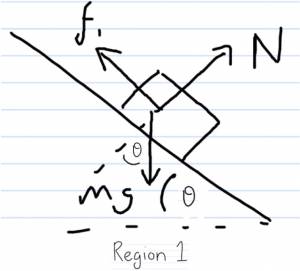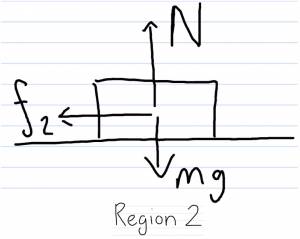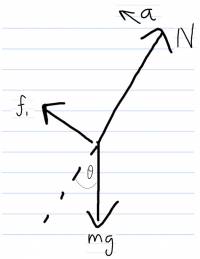Example: Sledding
A little girl is riding her sled on a hill. If she starts a distance d up the hill, which makes an angle θ with the horizontal, how far will she travel along the flat snowy ground?
Facts
Child on incline of θ.
The total mass of the sled and child = m.
There's a small bit of friction between the rails of the sled and the snow = (μ_k).
Slope length = L
Initial state: at rest, at height above horizontal
Final state: at rest on horizontal
Lacking
How far will she travel along the flat?
Approximations & Assumptions
Coefficient for kinetic friction for flat + incline is the same.
No wind resistance.
Representations
System: Sled + Kid + Earth
Surroundings: Snow
$$\Delta E_{system} = W_{surroundings}$$
$$\Delta K + \Delta U_{g} = W_{friction}$$
Solution
We could solve this using forces of kinematics; but, let's apply the energy principle because we can avoid vector quantities in the calculation.
First we must decide the system and surroundings.
System: Sled+Kid+Earth Surroundings: Snow
Starting with the principle that change in energy in the system is equal to the work done by the surroundings.
$$\Delta E_{system} = W_{surroundings}$$
The change in energy can be in the form of change of kinetic and change in gravitational potential energy.
$$\Delta K + \Delta U_{g} = W_{friction}$$
No change $$ \Delta K = 0$$ as its initial and final state of the sled is at rest.
$$\Delta U_{g} = W_{friction} \longrightarrow W_{friction}?$$
Here, we pause because we have two different regions to consider.
The frictional force is different in the two regions so we must consider the work they do separately.
$$\Delta U_{g} = W_{1} + W_{2}$$
Breaking work down into force by change in distance.
$$\Delta U_{g} = \vec{f}_{1}\cdot\Delta \vec{r}_{1} + \vec{f}_{2}\cdot\Delta \vec{r}_{2}$$
$\vec{r}_{2}$ is what we are trying to solve for as this is the position change along flat part.
What's $f_{1}$ and $f_{2}?$
Need to find $f_{1}$ & $f_{2}$
To find $F_{1}$ we can say that the sum of the forces in the x direction are equal to $ma_{1}$ But we don't need this because we know that $f_{1}=μ_{k}N$.
$\sum{F_{x}} = f_{1} - mgsinθ = ma_{1}$
The sum of the forces in the y direction we do need because this allows us to express N.
$$\sum{F_{y}} = N - mgcosθ = 0$$
$$mgcosθ = N$$
If $f_{1}=μ_{k}N$ then:
$$f_{1} = μ_{k}mgcosθ$$
To find $f_{2}$ we must do the same thing and add all the forces in the x and y directions. Again because not using kinematics we don't need accelerations and instead want an equation that expresses $f_{2}$.
$$\sum{F_{x}} = f_{2} = ma_{2} \longrightarrow f_{2} = μ_{k}N = μ_{k}mg$$
$$\sum{F_{y}} = N-mg = 0$$
We substitute in for $f_{1}$, $f_{2}$ and d the distance down the slope into the previous equation for gravitational potential energy with minuses on the $\vec{f}'s$ as they are in opposition of the $\vec{r}'s$.
$$\Delta U_{g} = \vec{f}_{1}\cdot\Delta \vec{r}_{1} + \vec{f}_{2}\cdot\Delta \vec{r}_{2}$$
In the previous equation $\vec{f}_{1}\cdot\Delta \vec{r}_{1} \longrightarrow W_{1}<0$ and $\vec{f}_{2}\cdot\Delta \vec{r}_{2} \longrightarrow W_{2}<0$ because $\vec{f}$'s are opposite to $\Delta \vec{r}$'s
$$\Delta U_{g} = -(μ_{k}mgcosθ)d - (μ_{k}mg)x$$
Substitute in the equation for gravitational potential energy for $\Delta U_{g}$
$$+mg(y_f - y_i) = -μ_{k}mgdcosθ - μ_{k}mgx$$
Rearrange to get the following expression.
$$y_f - y_i = -μ_{k}(dcosθ + x)$$
What is $y_f-y_i$ in terms of what we know? Eventually we want to express x in terms of variables we know.
From the diagram of the incline we get:
$$y_f-y_i = -dsinθ$$
Substitue $-dsinθ$ for $y_f-y_i$ and then rearrange to express x in terms of known variables.
$$-dsinθ = -μ_{k}(dcosθ + x)$$
$$dcosθ+x = \dfrac{d}{μ_{k}}sinθ$$
$$x = \dfrac{d}{μ_{k}}sinθ - dcosθ$$
$$x = d (\dfrac{sinθ-μ_{k}cosθ}{μ_{k}})$$
A check of the units reveals that:
[x]=m
[d]=m
Which makes sense as all the other quantities are unit less.
$E = γmc^2$





